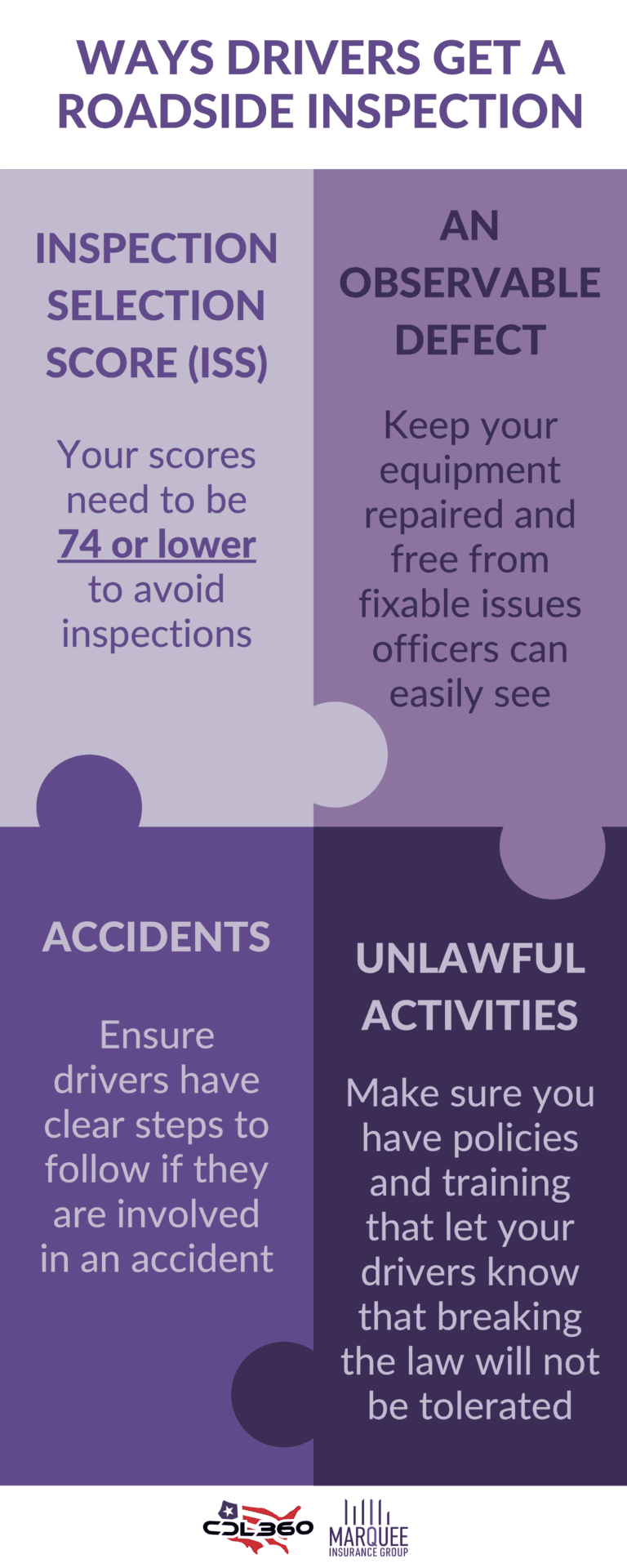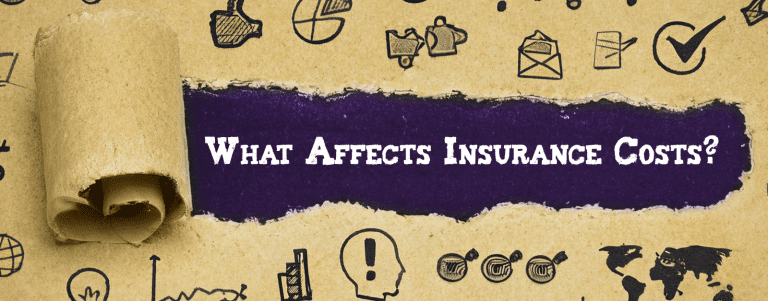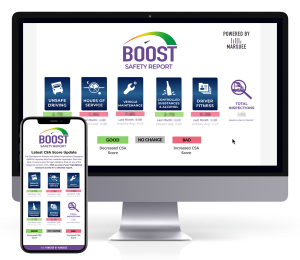Avoiding Roadside Inspections & Violations
There are four ways your drivers can get a roadside inspection:
- Inspection Selection Score (ISS)- your scores need to be 74 or lower to avoid inspections.
- An Observable Defect- keep your equipment repaired and free from fixable issues officers can easily see.
- Unlawful Activities- make sure your policies and training demonstrate zero-tolerance for breaking the law.
- Accidents- all units will be inspected if an accident occurs. Ensure drivers have clear steps to follow if they are involved in an accident.
Observable Defects and Unlawful Activities trigger other roadside inspection violations. If you limit these two BASICS as well as have a low ISS, the frequency of your roadside inspections drastically decreases.
CSA BASICs
The CSA Behavior Analysis and Safety Improvement Categories (BASICs) organize data from roadside inspections. From this data, a score is given for each category. Our partner, CDL Consultant, has the knowledge and services to help lower your scores. See what their CEO Justin Seyl had to say:
Category 1: Unsafe Driving BASIC
The easiest way to avoid receiving roadside inspections is to drive safely and legally. However, we understand drivers happen to get tickets. Having a nationwide ticket solution for drivers that offers dataq challenges, can reduce your Unsafe Driving BASIC by up to 58%. Also, ensure your drivers report ALL tickets to your company. This improves the effectiveness of fighting them. All in all, CDL Consultant offers nationwide court representation on behalf of you or your drivers. They get over 95% of our cases reduced or dismissed with no membership fees or court appearances.
Category 2: Vehicle Maintenance BASIC
Learn the several steps companies should take to lessen the increase of CSA points on your Vehicle Maintenance BASIC:
1. Keep your CMV clean.
2. Make sure your drivers complete their Driver Vehicle Inspection Reports (DVIRs).
3. Review recent CSA scores to understand where your fleet struggles. Put in place a “focused” pre-trip inspection where the most common violations occur. For example, if your CMVs receive citations for flat tires or audible air leaks, make the driver check those issues consistently.
4. Put into place a Preventative Maintenance Program. Doing this helps avoid these violations by not letting them grow into an issue in the first place.
Category 3: Hours of Service BASIC
Of the top 20 driver violations received during roadside inspections, hours of service account for 10 of them. Some things that can be done to minimalize the impact of these CSA points:
1. Provide ongoing driver training.
2. Ensure all drivers possess the In-Cab paperwork. This includes the ELD User’s Manual, the Instruction Sheet, and at least 7 days’ worth of paper logs. Also, encourage the drivers to fill out all required fields.
3. Schedule your loads with extra time. This secures the driver doesn’t violate the Hours of Service Regulations.
4. Regularly audit logs. Focus on those drivers that struggle the most.
Category 4: Crash Rate BASIC
Operating a CMV is a huge responsibility, and the FMCSA focuses on keeping the general motoring public safe. Companies should provide a proactive stance regarding accidents to assist in the FMCSA’s mission. Try placing drivers through periodic defensive driving courses. Reach out to CDL Consultant to learn more about their unlimited driver training programs.
Category 5: Controlled Substance and Alcohol BASIC
Focus on determining what kind of controlled substance and alcohol policy you will implement. Options include, but are not limited to:
1. Putting a zero-tolerance policy in place.
2. Allowing the driver to come back to work after they complete an SAP program.
3. Return to duty process.
4. Going through the FMCSA’s Clearinghouse.
Category 6: Hazardous Material Compliance BASIC
Transporting hazardous materials is an extremely dangerous endeavor. The FMCSA wants carriers transporting hazmat materials to stay compliant with PHMSA (Pipeline and Hazardous Materials Safety Administration) regulations. Make sure to take the proper steps in order to complete successful roadside inspections.
Category 7: Driver Fitness BASIC
The main reason these violations occur during roadside inspections is that the CDL holder’s license is suspended. Suspensions trace back to several things like not paying a fine on a citation, not turning in a medical card, and even not paying child support. Prevent violations by doing the following:
1. Sign your drivers up for a license monitoring service. These services monitor your drivers’ CDLs for convictions and suspension. If one of those should occur, you will get an email alert notifying you of the issue.
2. Every time a driver updates their medical card, the responsibility falls on the carrier. They must ensure the new information exists on the driver’s MVR. After 15 days of turning in an updated medical card to the state, the company MUST check the driver’s MVR or with the DMV. Either of these shows if the new information has been entered into the state’s database.
If you need to learn more on how to avoid roadside inspections, safety office help, dataqs, CDL monitoring, driver corrective action training, hiring, DA consortium, CSA score management, citation help, accident mitigation, or just need someone to answer your questions, call CDL Consultant at 888-224-2019.







